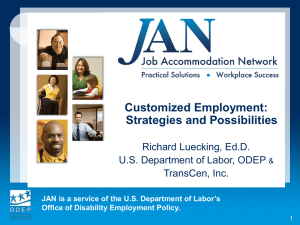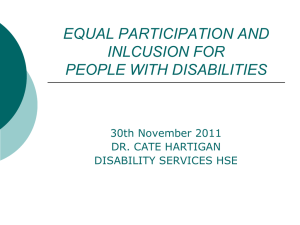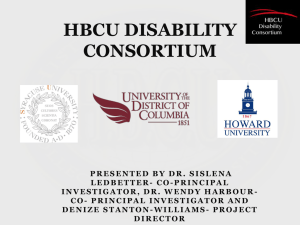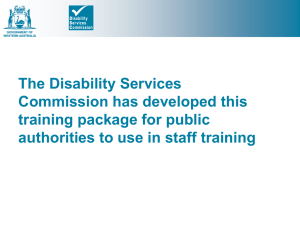View the slides from this presentation
advertisement
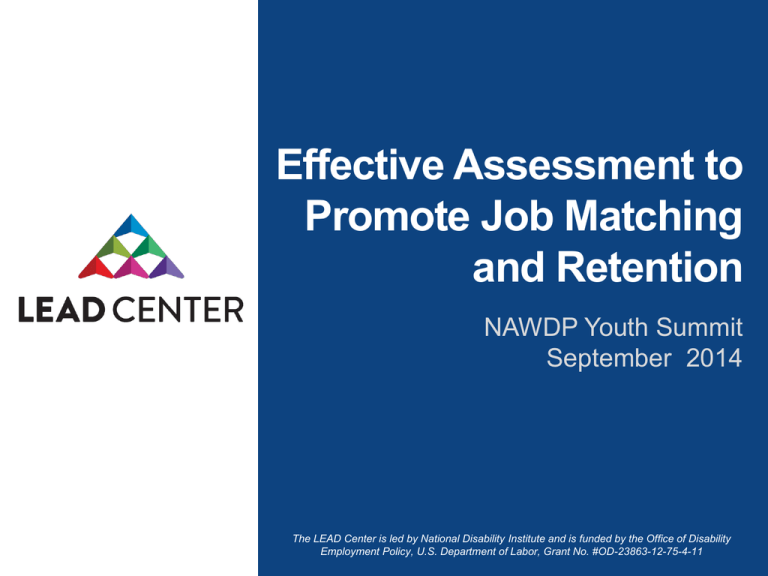
Effective Assessment to Promote Job Matching and Retention NAWDP Youth Summit September 2014 The LEAD Center is led by National Disability Institute and is funded by the Office of Disability Employment Policy, U.S. Department of Labor, Grant No. #OD-23863-12-75-4-11 TODAY’S SPEAKERS Rebecca Salon, PhD. LEAD Center, Project Director National Disability Institute Elizabeth Jennings LEAD Center, Assistant Project Director National Disability Institute 2 The National Center on Leadership for the Employment and Economic Advancement of People with Disabilities (LEAD) is a collaborative of disability, workforce and economic empowerment organizations led by National Disability Institute with funding from the U.S. Department of Labor’s Office of Disability Employment Policy, Grant No. #OD-23863-12-75-4-11. 3 LEAD CENTER MISSION To advance sustainable individual and systems level change that results in improved, competitive integrated employment and economic self-sufficiency outcomes for individuals across the spectrum of disability. 4 OBJECTIVES Participants in this session will: Identify alternative forms of assessment that better ensure a good job match for youth with disabilities to promote career development and job retention Explore Universal Design strategies to successfully serve all youth who may face barriers to employment Examine resources, strategies and products that promote success and represent best practices for working with youth with and without disabilities Discuss successes and barriers faced by youth and workforce professionals in achieving employment outcomes and economic self-sufficiency 5 # 1 FACTOR PREDICTING POST-SCHOOL CAREER SUCCESS: WORK EXPERIENCE IN HIGH SCHOOL #2 FACTOR PREDICTING POST-SCHOOL CAREER SUCCESS: SUPPORTS TO MAINTAIN EMPLOYMENT WHAT COUNTS AS WORK EXPERIENCE? Any activity that puts youth in the workplaces and offers opportunity to learn about careers, jobs and work behavior Work Experiences include: Job shadowing Job sampling Internships Apprenticeships Paid jobs (part or full time; part of the curriculum or not; during or after school) DIFFERENT APPROACHES FOR PEOPLE WHO FACE SIGNIFICANT BARRIERS TO EMPLOYMENT Place and Train vs. Train and Place Negotiating a job description with tasks that a person CAN do vs. trying to “fit” them into an existing job description Ensuring that the job is a good match vs. Place and Pray Figuring out ways to support them long-term in a job that is a good fit, with one or more people in their support network 9 CUSTOMIZED EMPLOYMENT (CE) Customized employment (CE) is a universal strategy designed to personalize the employment relationship between an employer and employee to meet the needs of both. CE creates an individualized match between the strengths, conditions, and interests of a job candidate or employee and the identified business needs of an employer. http://www.dol.gov/odep/topics/CustomizedEmployment.htm and http://www.leadcenter.org/employment 10 A DIFFERENT APPROACH TO JOB DEVELOPMENT AS WELL Labor Market Job Development: Responding to the needs of employers with applicants who are “qualified” to meet those general needs. Customized Job Development: Discovering the “strengths, needs and interests” of applicants and negotiating a job description that meets both the applicant’s and employer’s specific needs. 11 CE CIRCUMVENTS A COMPARATIVE AND MORE COMPETITIVE APPROACH Traditional job development strategies: Vocational Assessment Resume development Interview practice Responding to posted jobs (workforce system, posted ads, Craig’s List, etc.) Applications and Interviews 12 A Customized Approach: Discovery Profiles that may include portfolios, picture or video resumes Informational Interviews/connections Matching of skills and employer needs Employment proposals CUSTOMIZED EMPLOYMENT: A UNIVERSAL HUMAN RESOURCES BEST PRACTICE “We saw first-hand how customization fosters a workplace that is happier and more engaged, and how organizations achieve marketplace advantage through improved employee performance and productivity. Why? Because when jobs are customized to individuals…people’s work tasks become better aligned with their actual strengths.” Susan Cantrell & David Smith. (2010). Workforce of One: Revolutionizing Talent Management Through Customization. (p. 6-7) 13 CUSTOMIZED EMPLOYMENT: A UNIVERSAL HR BEST PRACTICE (CONT’D) “The great organizations of today and tomorrow capitalize on difference and they provide supporting structures to enable individuals to bring out their best at work.” “Improving how people perform through customized work experiences could even be considered the “last” competitive advantage, one that’s thus far untapped.” Susan Cantrell & David Smith. (2010). Workforce of One: Revolutionizing Talent Management Through Customization. (p.8, 14) 14 WHAT ARE NEGOTIATED JOBS? Identifies needs of employers that match the skills and interests of a job seeker. Job creation removes the job seeker from the comparative process by focusing on tasks that could benefit the business. A proposal is developed to address how job seeker can meet needs of employer. The employer only has to decide if this individual can meet one or more unmet need. 15 DIFFERENT COMPONENTS OF WORK When it occurs – time What you do – tasks Interactions – people, email, phones Pacing – speed Environment – outside, inside, noise, quiet Expectations – supervisor, co-workers, customers COMPONENTS OF A CUSTOMIZED APPROACH Discovery (Gathering Information) Development of a Profile (Written summary of what was learned in Discovery) Development of a Customized Employment or Job Search plan Engage in Local Research and conduct Informational Interviews (Discovering employer and community needs) Propose employment opportunities or, for selfemployment, assess business feasibility Always take advantage of the person’s networks and your own 17 CUSTOMIZED EMPLOYMENT RESOURCES APSE (Association for Persons in Supported Employment) www.apse.org Marc Gold & Associates www.marcgold.com Griffin-Hammis Associates www.griffinhammis.com Office of Disability Employment Policy (ODEP) http://www.dol.gov/odep/topics/CustomizedEmployment.htm TASH http://tash.org/ TransCen http://www.transcen.org 18 DOL DEFINITION OF UNIVERSAL DESIGN The use of common strategies that reinforce the concept of an inclusive setting that welcomes diversity, including products and environments that are accessible to and useable by all. The use of universal design strategies enables workforce staff to provide easier access, a welcoming atmosphere, and better customer service. Universal design strengthens practices to serve better persons with disabilities and other challenges to employment (e.g., people with a wide range of learning styles, languages, educational levels, intelligences, experiences, and abilities). Universal Design provides multiple and flexible methods to ensure that the learners acquire the information and knowledge they need. 19 WHAT IS UNIVERSAL DESIGN? Universal Design is a strategy for making products, environments, operational systems and services welcoming and usable to the most diverse range of people possible. Its key principles are simplicity, flexibility, ease of access and efficiency. It is a lens through which all aspects of interaction can be viewed, and can be applied to products, services, physical environments, communications, technology, policies and practices. http://www.dol.gov/odep/media/newsroom/universal.htm WHAT IS UNIVERSAL DESIGN (UD)? UD is a proactive approach that anticipates barriers people might face regardless of the cause and creates approaches to overcome or accommodate them. Developing services that are accessible to the largest number of people reduces the need for: specialized assistance, individualized accommodation requests, and delays while accommodations are put into place. DID YOU KNOW? An estimated 20% of the U.S. population are people with disabilities. Less than one-third of working age adults with disabilities are employed. People with disabilities are more likely to be unemployed and to live in poverty than any other single demographic group in the United States today. DID YOU ALSO KNOW? Public benefit programs for people with disabilities, especially Supplemental Security Income (SSI), are not aimed at increasing assets and independence for people with disabilities. More so then any other population on a fixed income, services and policies do not hold the expectation of economic selfsufficiency. 23 CHARACTERISTICS OF PEOPLE WITH HIDDEN DISABILITIES People with hidden disabilities comprise as high as 25% of the population. (Some studies show as high as 1/3 of the TANF population) People with hidden disabilities have a range of abilities, levels of education, employment background, and ethnicities. A 2013 Secret Shopper Initiative by the LEAD Center and ASAN found that improved Universal Design was necessary to ensure access to programs and services. 24 EXAMPLES OF UNIVERSAL DESIGN Open/closed captioning Availability of screen readers Increasing font size on documents Curb cuts Voice activated applications Door handles that don’t require grasping, use push-bars, and/or have automatic or electronic door openers WHY IS UNIVERSAL DESIGN IMPORTANT TO THE WORKFORCE SYSTEM? Universal design makes access to services, jobs and learning accessible to all people, thereby serving the largest number of youth and adults, even without expertise in disability or knowledge of someone’s specific disability. Job seekers are encouraged to use alternate methods to represent themselves and their skills, abilities and talents. 26 WHAT CAN AJCS DO TO CONTINUE TO IMPROVE SERVICES TO PEOPLE WITH DISABILITIES? Offer assistance and accommodations to all customers rather than just to a particular population. Make information on all services available to all customers, avoiding assumptions that certain people may not be interested in some services. Provide choices (e.g., technology; physical settings; assessment approaches and tools; on-line, face-toface and self-directed approaches; accommodations for learning styles; etc.) WHAT ELSE CAN AJCS DO TO CONTINUE TO IMPROVE SERVICES TO PEOPLE WITH DISABILITIES? Eliminate unnecessary complexity and/or contacts Offer accommodations to everyone for literacy and language needs (e.g., include graphics, color-coding, larger print, etc.) Create on-line or video-taped versions of forms and materials, including orientation information ADDITIONAL RESOURCES DEI Technical Assistance Project http://www.dei-ideas.org/ Disability and Employment Community of Practice provides disability and employment resources for the public workforce system, including promising practices to promote the positive employment outcomes of persons with disabilities. http://disability.workforce3one.org For background information on the DEI: https://disability.workforce3one.org/page/tag/dei_project For the American Job Center Access Guide: https://disability.workforce3one.org/command/view.aspx?look=20014058 40432475887&mode=info&pparam For the American Job Center Access 30-Second Training Series: https://disability.workforce3one.org/view/1001403833465878171/info 29 ODEP http://www.dol.gov/odep/ QUESTIONS? THANK YOU FOR PARTICIPATING IN THIS SESSION! 30 CONNECT WITH THE LEAD CENTER Sign up for LEAD Center News here or at www.leadcenter.org Follow the LEAD Center on… Facebook: www.facebook.com/LEADCtr Twitter: @LEADCtr LinkedIn: linkedin.com/groups/LEAD-Center-4828089 YouTube: https://www.youtube.com/user/LEADCtr Rebecca Salon Project Director rsalon@ndi-inc.org 31 Elizabeth Jennings Assistant Project Director ejennings@ndi-inc.org
